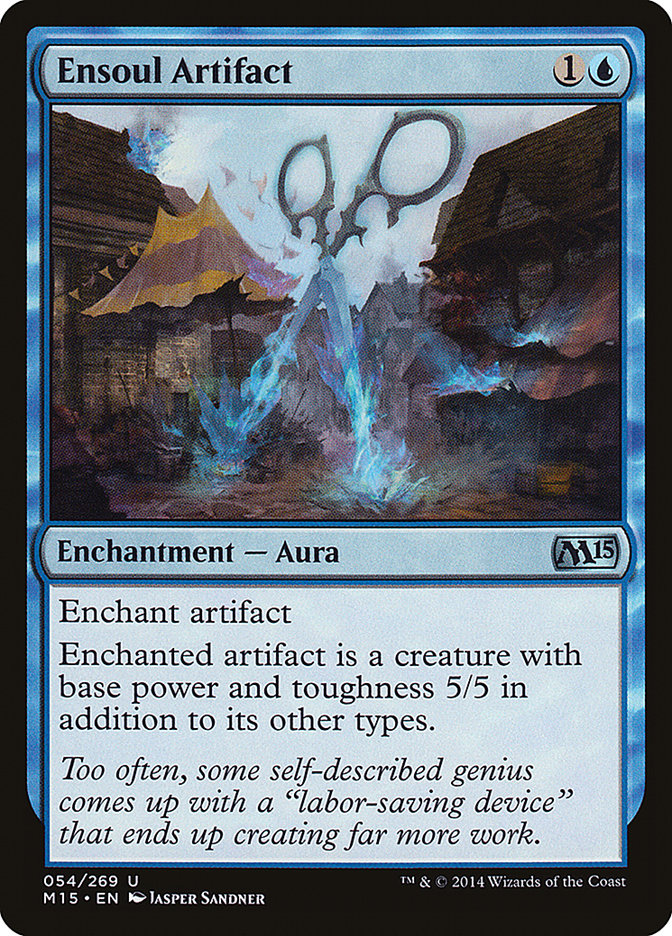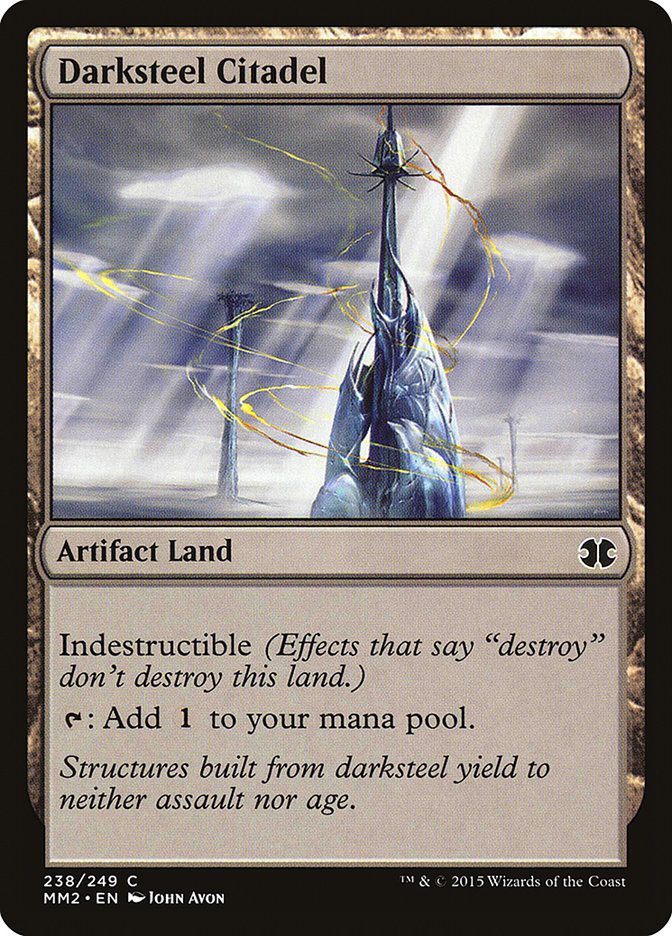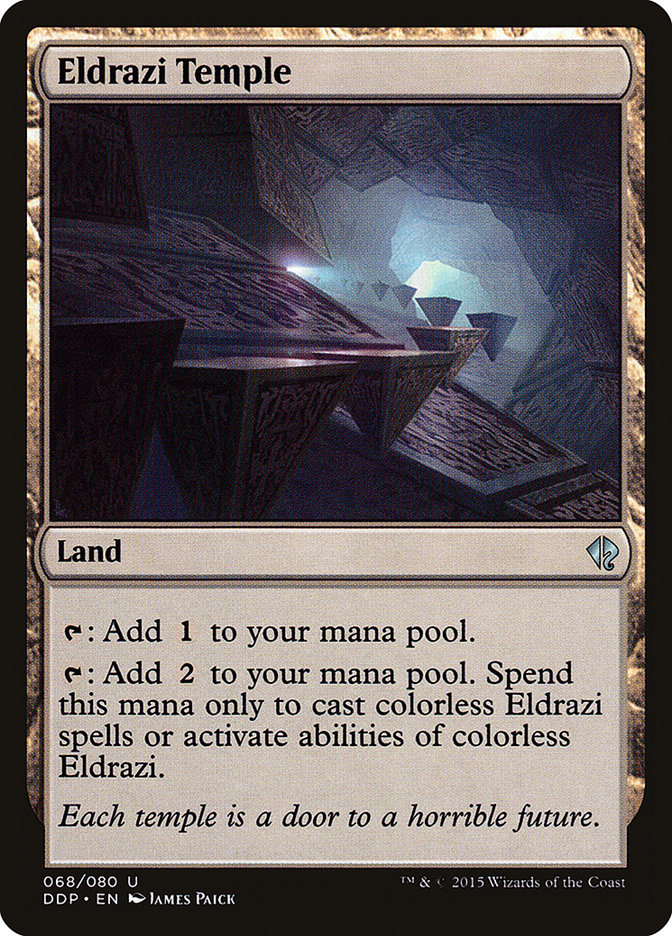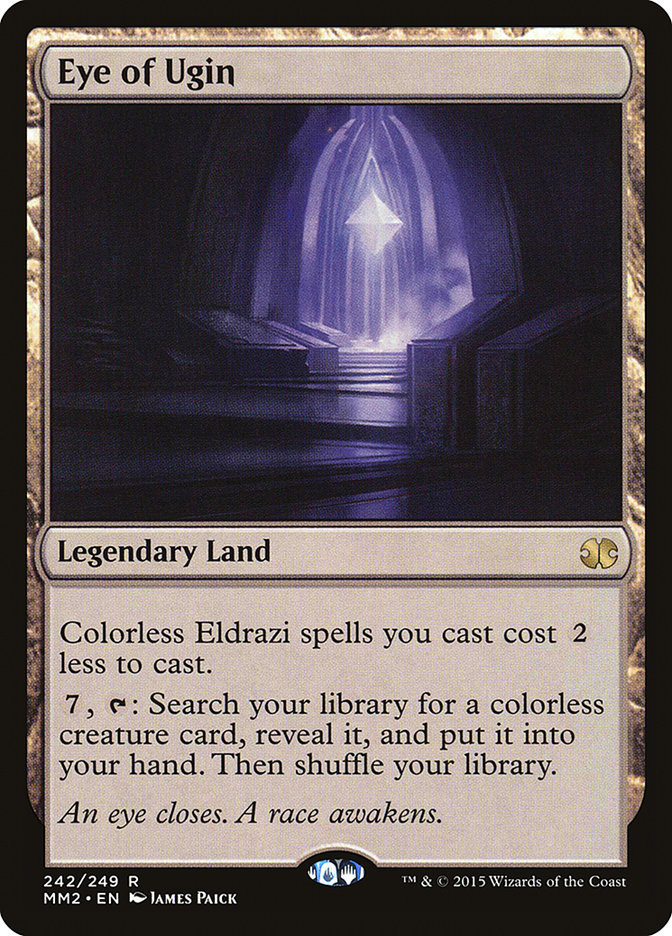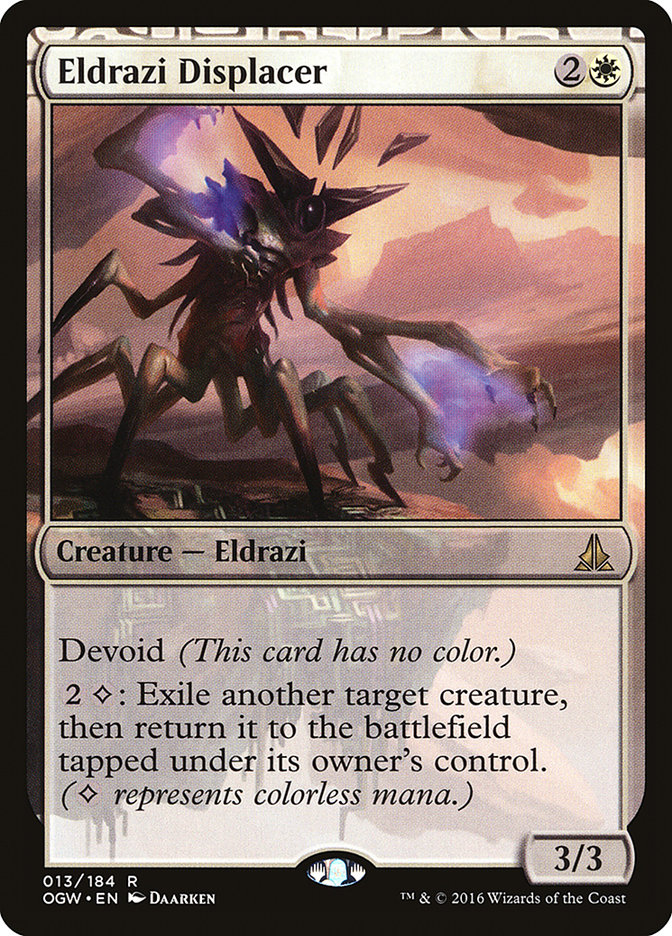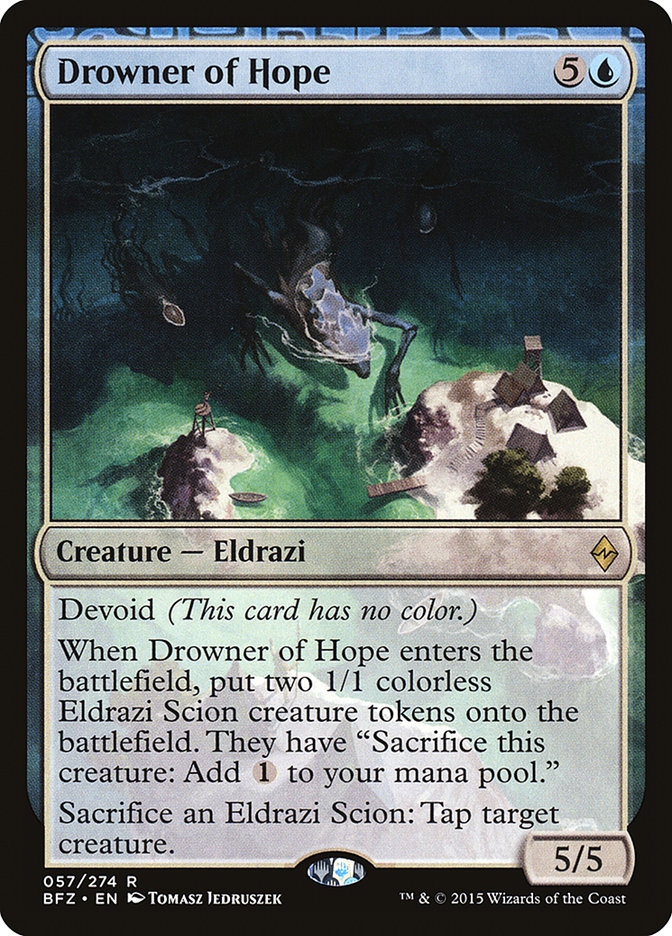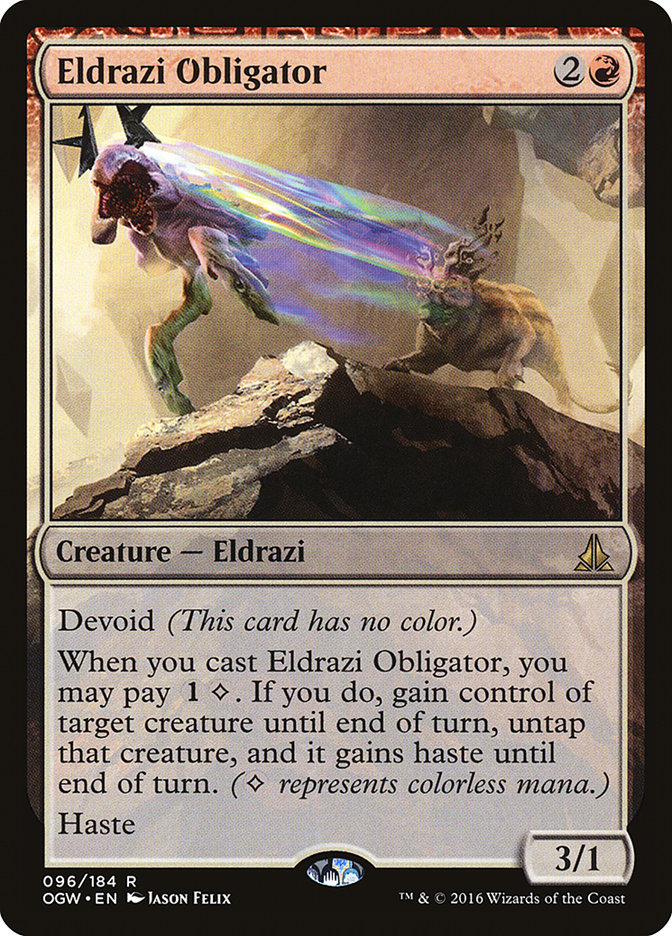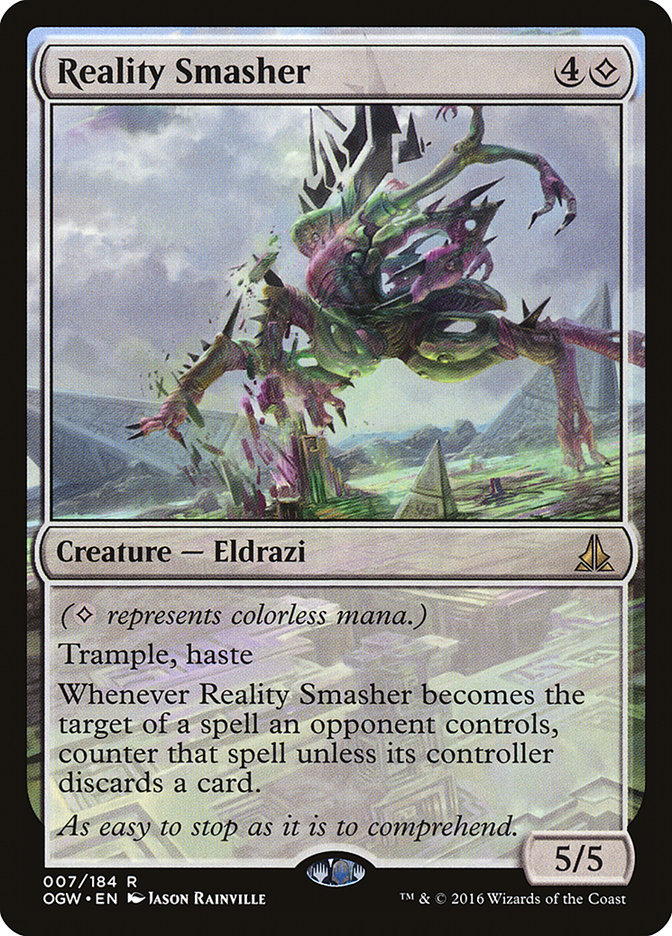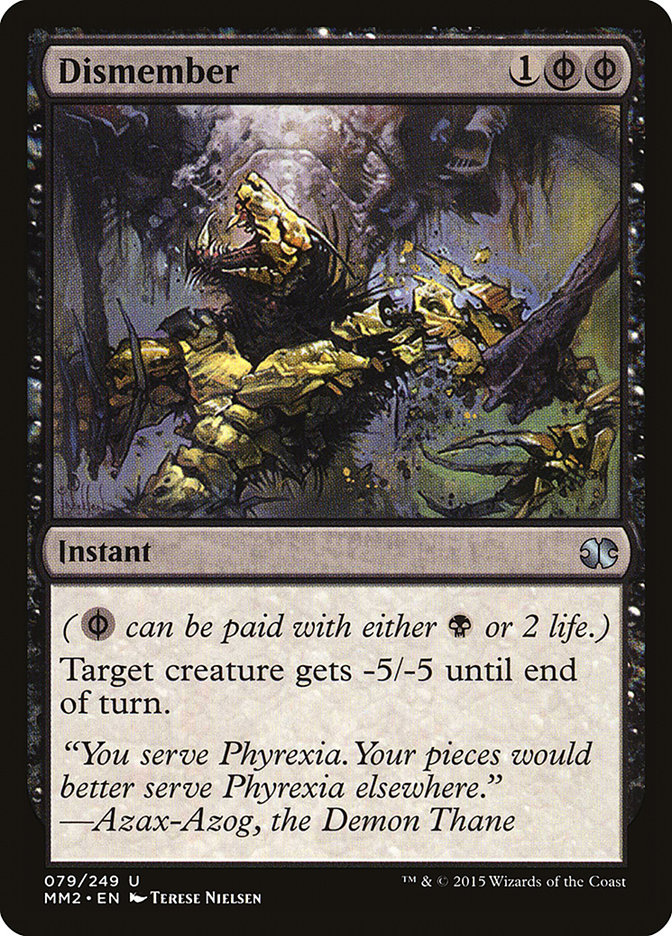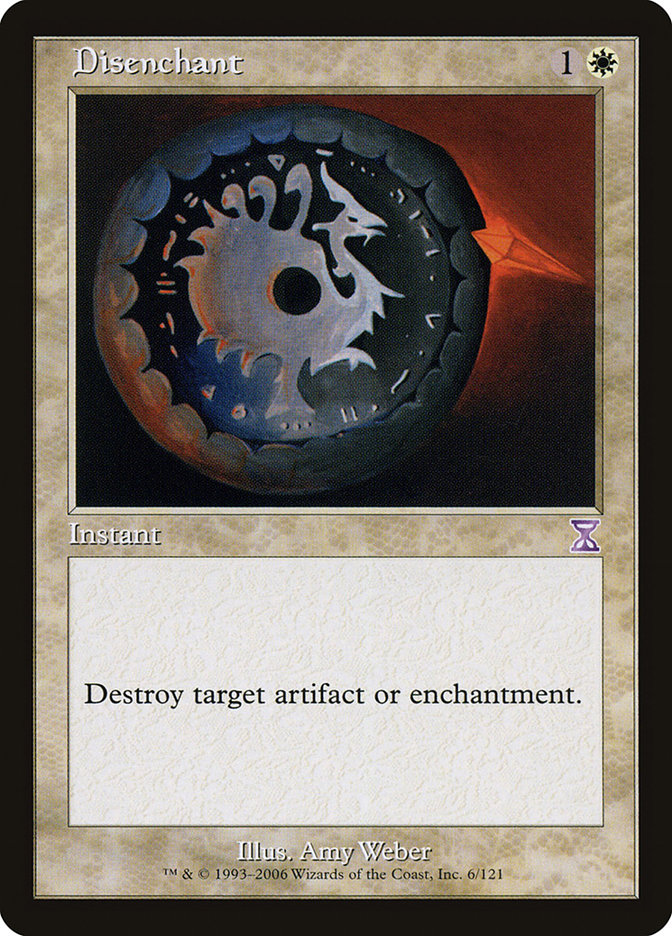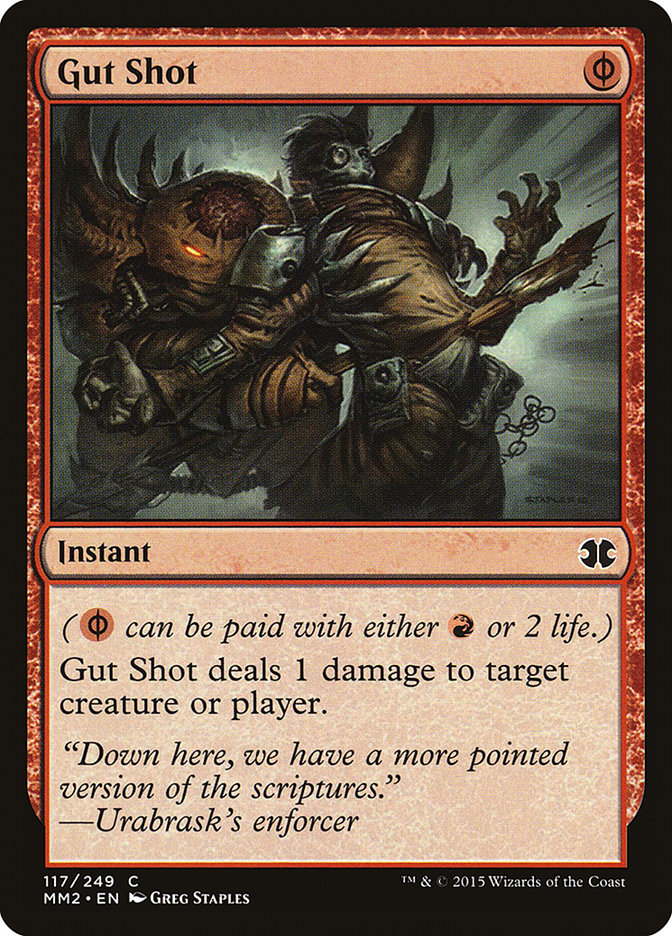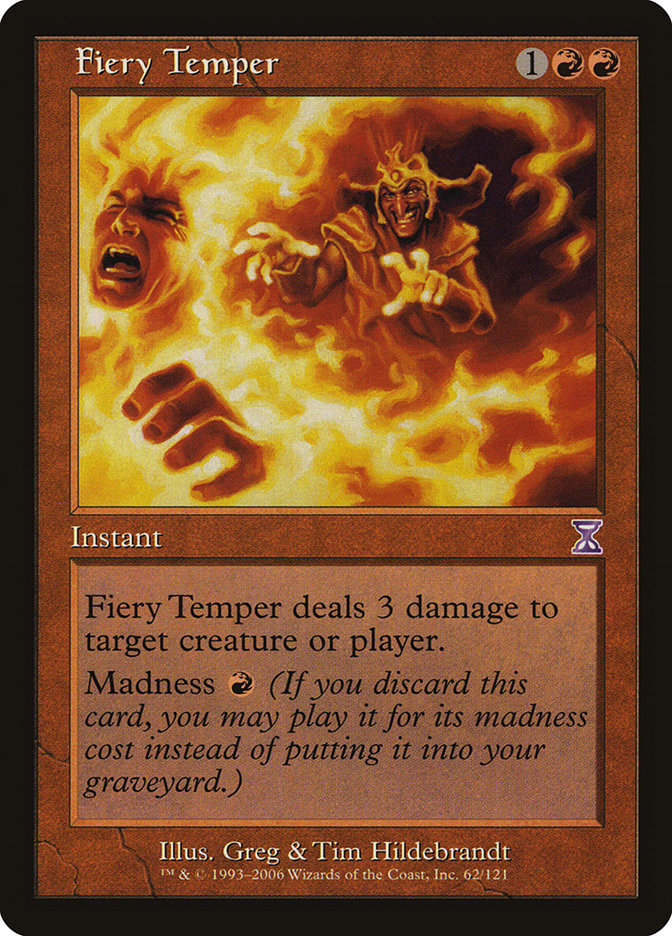I played Gerry Thompson’s U/W Eldrazi list this past weekend at #GPDET to a 12-3 finish after getting a last round concession.
Creatures (28)
- 4 Drowner of Hope
- 4 Endless One
- 4 Eldrazi Skyspawner
- 4 Eldrazi Mimic
- 4 Eldrazi Displacer
- 4 Reality Smasher
- 4 Thought-Knot Seer
Lands (25)
Spells (7)

I mentioned last week that I’d probably just resort to battling it out with eldritch monsters in Detroit and nothing that happened over the week deterred me from that choice. The Eldrazi decks are broken and around 83% of the finals slots among the three different Grand Prix across the world this past weekend being U/W Eldrazi decks does little to refute that statement.
I got losing in Modern out of my system a few weeks back. This season still feels like more of a gift than anything else so far, and I’ve been making a continued effort to make good decisions and not throw away opportunities to earn Pro Points.
In addition, I didn’t want to waste a chance to simply be the bad guy. Some of my stranger regrets in Magic are that I never got to play Caw-Blade in a tournament where it was at full power or enter the Delver rat race in Standard. This Eldrazi deck certainly won’t exist in its current form for a long time, so I don’t see a reason to not be a part of it while I can.
Thankfully, I also had the current lord of Eldrazi In my corner (and probably the only person on the planet that thinks they’re the good guys), and despite our list being more-or-less the epitome of average, Gerry was able to leverage it into a Top 8 berth in addition to my solid finish.
I won’t delve deep into the intricacies of the 75 we registered or how to go about adjusting it, as I’m sure Gerry has a lot more to say about that, but I do want to talk about some of the more abstract things that I noticed surrounding the Eldrazi deck specifically and my experiences in the tournament.
While I didn’t test all that much for Grand Prix Detroit, what experience I did get was critical – not necessarily with actual gameplay mechanics, but with mulligan decisions.
The two or three hours’ worth of games against Brad Nelson were nice and all, but having a hand quality consultant in Gerry Thompson was invaluable to my tournament.
The Vancouver Mulligan Rule Changed Everything
It’s not difficult to notice that Pro Tours specifically have been dominated by aggressive decks for the majority of the past year. While this can be attributed to the power level and pushing of certain strategies to some extent, I would argue that the trend has been a lot stronger since Face to Face’s U/R Ensoul Artifact deck at #PTORIGINS.
The Vancouver Mulligan rule has done wonders to smoothing out the early turns of games of Magic.
More specifically, the option to scry on smaller hand sizes allows aggressive decks to better leverage the advantages they have in the early game, typically the ability to constrict an opponent’s resources on a variety of axes. A lower raw card count becomes an issue far less frequently because an opponent will simply not always have the time to deploy all of their resources.
This notion is pushed to the nth degree with Eldrazi due to how explosive the deck is capable of being with one or more “Eldrazi Lands.”
When your opponent is being attacked for ten on turn 3, it doesn’t matter if you have no cards remaining; you’ve already won! There is little incentive for trying to keep mediocre hands.
While it may be scary to have the discipline to be willing to mulligan to five every other game, it hardly matters, as the Eldrazi strategy just decimates everyone else on deck quality when they have access to an Eldrazi Temple or Eye of Ugin in conjunction with one-mana removal spells and even have a functional late-game as a contingency plan.
This serves as a nice transition for my next observation:
The Value of Role Assessment
U/W Eldrazi was most the visible Eldrazi deck at all three Grand Prix this weekend. While I don’t have access to all the numbers, it would certainly appear from the elimination rounds to also be the most dominant. The Top 32 of Detroit certainly had a strong display of the aggressive R/G Eldrazi deck from the Face to Face contingent, but even then the key word here is “aggressive.”
Eldrazi Displacer, Drowner of Hope, and Eldrazi Obligator are all aggressively slanted cards. The Eldrazi deck’s best draws involve a quick explosion of cards on absurd rates, and that is why the deck is unfair. Cards like World Breaker and Ancient Stirrings allow the deck to theoretically beat hate and keep a wider range of hands respectably, but they make opening hands and getting off the ground more difficult.
The strength of Thought-Knot Seer is that it is able to effectively target hate cards as early as turn 2 while also providing a potent clock with which to restrict an opponent’s means to fight back in the timeframe that is necessary.
These Eldrazi decks that are messing around, like R/G and Tron, are theoretically great for having late-game trumps, but U/W is more than capable of doing the same, even if it might have to get more creative than simply triggering an Ulamog, the Ceaseless Hunger.
As I alluded to a moment ago, while the most potent weapon in the Eldrazi arsenal is their speed, they can also play a strong game in the later turns.
Eye of Ugin, Eldrazi Displacer, and Drowner of Hope give U/W Eldrazi the means to go toe-to-toe with basically anyone interested in getting on the battlefield and serve as insurmountable trumps in terms of creature combat inevitability. The former even allows for some weird back-door ways to fight against hate cards like Ensnaring Bridge, Ghostly Prison, and Worship.
In Gameplay
Perhaps the most surprising thing about U/W Eldrazi to me is that the games are actually fun to play.
Again, not to beat a dead horse, but Plan A is always going to be leveraging the speed and rate of your cards.
That being said, U/W Eldrazi is able to seamlessly transition between offense and defensive stances toward playing a long game, and identifying when to do so can be a tricky thing.
Effectively, after mulligans, the games feel a lot more like Limited than Constructed, which is certainly an interesting and refreshing dynamic.
Eldrazi Displacer and Drowner of Hope are also quite difficult to play against and can be incredibly punishing whenever either I or my opponent misevaluated the pace of the game and when to properly get aggressive or turtle up.
In mirror matches specifically, it felt like the games came down to proper role assessment and life total management, oftentimes in positions where those evaluations could change in simply a turn cycle or two.
For example, it is both difficult and rewarding to choose the right turns to double-block an opponent’s Reality Smasher, oftentimes giving them a card because of your Thought-Knot Seer’s death, but also costing four additional points of damage on the following turn.
The tension of cards with Phyrexian mana like Dismember makes these tough decisions even harder, whether they’re in one’s hand or potentially on top of their deck. Further, the high quality of the cards present, particularly in mirror matches, makes leveraging small advantages of the utmost importance; games need to be closed quickly lest these small edges slip away.
It is certainly possible, and I was more on the fortunate side than not, to “nut-draw” an opponent, but the majority of the games where both players properly mulligan actually become interesting positioning battles that are quite enjoyable.
This does not speak to the health of Eldrazi as a whole, but rather that I wouldn’t actually point to the mirror matches as a heavy strike against the rampancy of the deck.
There did seem to be one consistent advantage I had against my opponents in the majority of my mirror matches, however:
Diluting Your Deck Through Fear
The number of times that I killed my opponent in post-sideboard scenarios where they had cards like Disenchant, Stubborn Denial, or even Gut Shot rotting in their hand after I stripped their important cards with Thought-Knot Seer is mind-boggling to me.
While it may “feel bad” to potentially lose to cards like Worship, the fact of the matter is that diluting one’s deck to try to out-tech one another’s sideboard is not a winning strategy in a mirror match that is so heavily predicated on tempo and aggression.
Oftentimes I was basically drawing dead to an opponent who may have drawn Worship on a critical turn, but it didn’t matter because I was killing them!
Another nod towards this strategy being problematic is the presence of Thought-Knot Seer. Even if my plan were to stick Worship, who’s to say that I can’t just clear the way with my Thought-Knot Seer? Are you supposed to sideboard in two, three, or even four ways to fight opposing powerful permanents?
Not only are these cards awkward in terms of when they need to be drawn to line up well, but they also just contribute to making the deck mulligan worse. You probably can’t keep a hand with only one creature, even if “Eldrazi mana” is present.
I got the impression that a number of my opponents this weekend were afraid to “look stupid” or be drawing dead to a targeted hate card, and as a result, they made their deck worse than mine in a straight-up fight, allowing even my weaker range of draws to capitalize on their configuration.
Time Is Almost Up
I don’t expect the Eldrazi to remain unscathed come the next wave of bannings, but that’s not to say that a weaker version of the deck couldn’t still prove to be a viable choice if it isn’t burned to the ground. The deck is so powerful and (to some extent) customizable that it is possible it could continue to exist, particularly in a more balanced world where it doesn’t have a massive target on its tentacle.
Grand Prix Detroit may prove to be the last tournament that I ever get to play Eldrazi in, but it was an enjoyable experience that paid off.
Next week is #GPDC. Team Sealed tournaments are always a blast, win or lose, and I’m looking forward to doing battle with Todd Anderson and Tom Ross, even if it means having to teach Todd the names of a bunch of commons all this week!
Shadows over Innistrad is also beginning to loom ever closer, and I can’t wait to pair Jace, Vryn’s Prodigy with the return of madness.
What new spoilers are you excited about?





